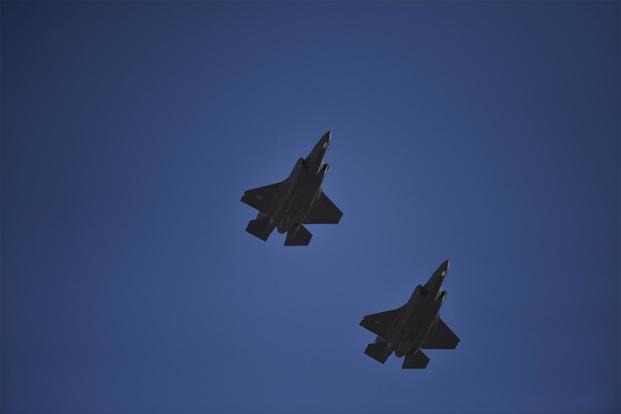The U.S. Air Force's F-35A variant has officially deployed to the Middle East.
Air Forces Central Command announced Monday that F-35 fifth-generation fighters from the 388th and 419th Fighter Wings at Hill Air Force Base, Utah, have deployed to Al Dhafra Air Base, United Arab Emirates to keep watch in the region.
It's the first time Air Force F-35s have deployed to the Middle East.
"We are adding a cutting-edge weapons system to our arsenal that significantly enhances the capability of the coalition," Lt. Gen. Joseph T. Guastella, commander of AFCENT, said in the release. "The sensor fusion and survivability this aircraft provides to the joint force will enhance security and stability across the theater and deter aggressors."
"The F-35A provides our nation air dominance in any threat," added Air Force Chief of Staff Gen. David Goldfein. "When it comes to having a 'quarterback' for the coalition joint force, the interoperable F-35A is clearly the aircraft for the leadership role."
Previously, that mission was held by the F-35's stealthy cousin, the F-22 Raptor.
The F-22s for years provided air cover for partnered ground forces conducting operations against the Islamic State. Also based at Al Dhafra, the F-22 has played a critical role in intelligence-gathering during the conflict.
Because of its advanced stealth technology and powerful sensors, the F-22 has frequently been the first coalition plane in hostile airspace after a major incident. Such was the case following the 2017 U.S. shootdown of Syrian aircraft and the Navy's Tomahawk missile strike on Shayrat Air Base in Syria the same year.
Related content:
- Air Force Sees Unique Challenges in Deploying Stealth Fighters
- F-22s Fire Warning Flares at Russian Jets in Coalition Territory
- F-15C Takes Over Anti-ISIS Ops After F-22 Comes Home
The Raptors, from the 1st Fighter Wing and 94th Fighter Squadron at Joint Base Langley-Eustis, Virginia, officially came home last fall.
While officials have not said if the F-22 will return to the fight against the Islamic State, the F-35 can offer similar capabilities in the meantime.
"The F-35A is designed with the entire battlespace in mind, and is intended to fuse, integrate and share data with other battlefield assets," officials said in the release. "It has one of the most powerful and comprehensive integrated sensor packages. It improves lethality, survivability and adaptability against emerging threats in order to maintain air superiority."
AFCENT on Monday stressed the deployment remains routine.
"This is a scheduled deployment," said Maj. Holly Brauer, AFCENT spokeswoman, in an email to Military.com. "The U.S. Air Force regularly deploys to support operations and other requirements. This deployment is one of many that allow U.S. and regional partner nation's militaries to train and work together to strengthen military-to-military relationships, promote regional security, improve combined tactical air operations and enhance interoperability of forces,"
Brauer did not disclose whether the F-35As would also operate in Afghanistan in coming weeks.
Last year, the Marine Corps' F-35B variant deployed for the first time to the region aboard the amphibious assault ship Essex following missions in the Pacific. That September, it made its combat debut in Afghanistan. The Air Force previously deployed F-35s to England and then to the Pacific in 2017.
The deployment news comes as the Trump administration continues its pressure campaign against Iran, where its forces have been operating in close proximity to U.S. troops in Syria.
-- Oriana Pawlyk can be reached at oriana.pawlyk@military.com. Follow her on Twitter at @oriana0214.













